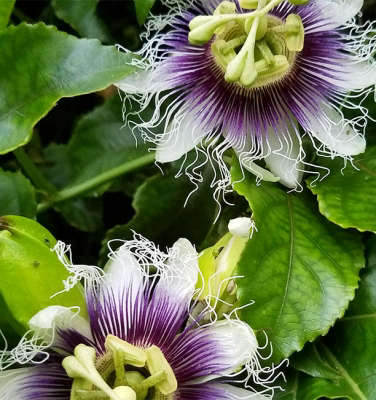

Passion flower vines are a good choice to cover walls, fences, and trellises with their unusual blooms that look like miniature ballerinas dressed in frilly, ornate tutus.
Fast-growing vines like passion flower are the best friends of gardeners with small plots because they add texture and color without taking up much space.
There are more than 500 species of Passiflora, and most produce show-off flowers with otherworldly silhouettes: stiff antennas on central coronas, surrounded by 10 cray0n-colored petals. In one growing season a passionflower vine can engulf a fence, wall, or pergola with exuberant green foliage and prolific blooms. Though they lend a tropical air to a garden, passionflowers are hardy in colder climates, as well (depending on the variety they’re perennials in USDA growing zones 5 to 11).
“In areas where the vine is not hardy, it can be grown outdoors in a container in summer and taken inside to a bright spot out of direct sun during winter (when it should be watered sparingly),” notes our contributor Jeanne Rostaing.
To keep it in check: “Avoid having a passionflower vine, which can easily grow 20 feet or more a year, run rampant over other plants by attaching it to a trellis or wire frame,” suggests Jeanne.
v5.0
When you register as a free Member of the Remodelista family of websites (Remodelista, Gardenista, and The Organized Home), you gain access to all current posts plus 10 archived posts per month, our internal bookmarking tool, and the community bulletin board.
Member benefits include:
For $5/month ($59.99 paid annually) you'll enjoy unlimited, ad-free access to Remodelista, Gardenista, and The Organized Home and all the benefits of Membership.
Subscriber benefits include:
For $5/month ($59.99 paid annually) you'll enjoy unlimited, ad-free access to Remodelista, Gardenista, and The Organized Home and all the benefits of Membership.
Subscriber benefits include:
Benefits include:
For $5/month ($59.99 paid annually) you'll enjoy unlimited, ad-free access to Remodelista, Gardenista, and The Organized Home and all the benefits of Membership.
Subscriber benefits include:
When you register as a free Member of the Remodelista family of websites (Remodelista, Gardenista, and The Organized Home), you gain access to all current posts plus 10 archived posts per month, our internal bookmarking tool, and the community bulletin board.
Member benefits include:
If at any time you want to become a Subscriber and enjoy unlimited, ad-free access to all our content, just go to the My Account link and choose Subscribe.
Advertising funds our work at Gardenista and helps us provide you with a daily dose of garden inspiration & design. We hope you’ll consider disabling your adblocker for Gardenista so we can continue our mission: a well-designed garden for all.
Thank you for your support.